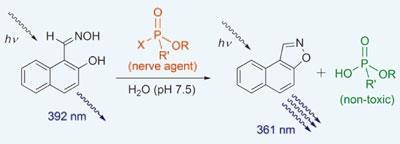US researchers develop chemistry to detect and neutralise lethal nerve agents
A new molecule that detects and destroys lethal nerve gases has been developed by researchers in the US. It is hoped that the research will help develop new early-warning systems against chemical weapon attacks, and possibly give rise to an effective antidote.
Originally developed during the lead up to the second world war, organophosphorus nerve gases such as sarin, tabun and soban are odourless and colourless - and exposure to even a small amount can be fatal within minutes. Despite being outlawed by chemical weapons conventions in the 1990s, their relatively straightforward chemical structure means they could conceivably be deployed by terrorist organisations, the most dramatic example of this being the attacks on the Tokyo subway in 1995.
Working with safer mimics of the nerve agents, Julius Rebek’s team at the Scripps Research Institute in La Jolla, California, designed a pincer-like molecule containing a hydroxy oxime group. The compound has several advantages over previous chemical sensors - being more sensitive and easier to deploy in the field, while still being extremely reactive and taking only milliseconds to detect the gas.

’Oxime is a well-known super nucleophile, and we use it to capture a weak electrophile - in this case the phosphorus halides on the nerve agents,’ Rebek told Chemistry World. ’The result is a spring-loaded device that snaps shut to destroy the agent before it can do harm.’ Immediately next to the oxime is an alcohol group, which allows the reacted molecule to quickly convert into a ring system after the nerve gas has been neutralised. This ring can be detected as a fluorescent dye - potentially allowing the amount of gas in the area to be measured, and the team have already started to design possible prototypes for badge-sized detectors.
Another line of inquiry is to use the compound as an active defence against the agents. ’We are trying to integrate these molecules into a formulation that could be used as an antidote for exposure to the nerve gases,’ Rebek says.
Nerve agents work by bonding to an enzyme called acetylcholinesterase and preventing it from breaking down the neurotransmitter acetylcholine. This bonding reaction occurs through the phosphorus halide group on the nerve agent - and since this is the group that is cleaved by the new chemistry, it is hoped that it might prove to be a successful antidote.
But Michael Sailor, who has worked on making similar compounds at the Universityof California, San Diego, US, is not convinced that this new method is better than other chemical sensors developed in recent years. This is because it is hard to make a direct comparison as different conditions have been used in each case.
Lewis Brindley
References
T j Dale and J Rebek Jr., Angew. Chem. Int. Ed., 2009. DOI: 10.1002/anie.200902820






No comments yet